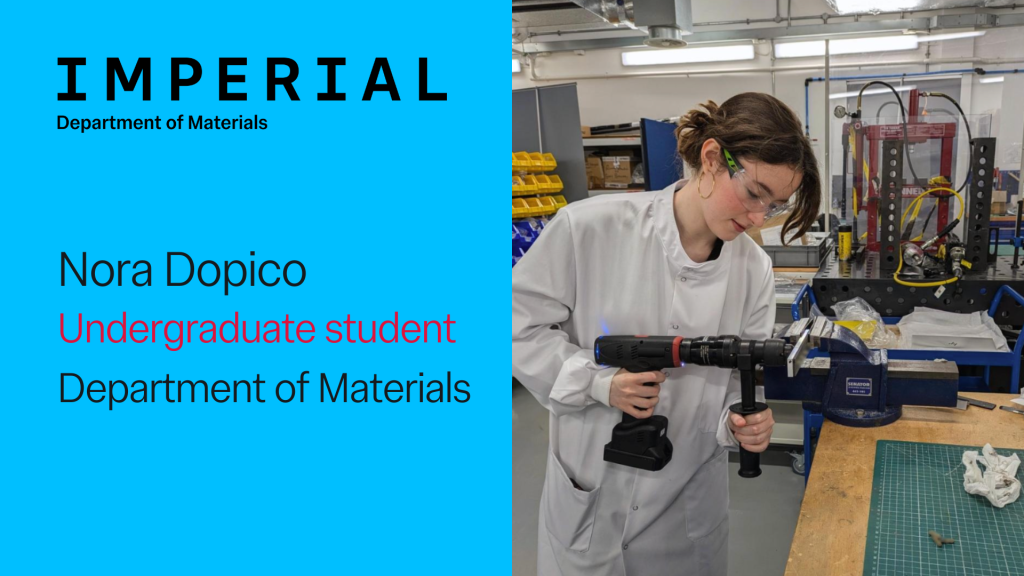
Nora Dopico is an undergraduate student in the Department of Materials. She has recently completed her third year and is currently completing a self-organised, year-long placement at Airbus. In this new blog post, she shares how she organised the placement, what the experience has been like, and how it will support her final year of study.
Can you tell us more about the placement?
I’m working in the Materials and Processes (M&P) department at Airbus, specifically in the Assembly Technology team. It’s based in the Advanced Integrated Research & Technology Centre (AIRTeC), its most advanced materials research and test facility, and Airbus’s primary site for the development of aircraft wings of the future.
The Assembly team covers a wide range of activities, such as qualifying new parts and answering quality issues. I’m part of a site working in Filton, that has been a cornerstone of British aerospace innovation for over a century. Originally the home of the Bristol Aeroplane Company, with its final flight returning to Filton in 2003.
Today, Airbus Filton is integral to designing wing structure, fuel systems, and landing gear integration for Airbus aircraft, and it also handles wing assembly for the A400M. It remains a thriving hub for aerospace engineering, shared with industry giants like Rolls-Royce and MBDA, and famously where much of the Concorde was both designed and built.
What tasks did your placement involve?
My role involves everything from dealing with in-service failures, to developing future generations of fastening systems, in collaboration with numerous suppliers from across the globe.
My key responsibilities include reacting to in-service Quality Issues by carrying out test campaigns and performing failure analysis, supporting qualification processes for new material sources and/or new suppliers, arranging testing procedures cross-nationally to evolve R&T fastening systems through the next stage of “Technology Readiness” , and more recently creating a simulation program to approximate the optimal geometry of a fastener component for a High Load Captive Nut problem.
So far, the team meeting in St Nazaire has been the highlight of my placement. This was an opportunity to meet the colleagues in Bremen, Toulouse and Getafe, to share ideas and visit the fuselage manufacturing facilities. Standing inside of A320-family and A350 fuselages as they were being assembled, and witnessing BelugaXLs take off for final assembly, gave me a real appreciation of the impact of our work. I also had the opportunity to see Airbus UK’s wing manufacturing operations up close during a visit to Broughton, helping me build an understanding of the company’s wider activities and the real-world impact of my team’s work.
What led you to explore this area of Materials Science?
Airbus is a global aerospace giant pioneering cutting-edge aircraft, helicopters, and space technology. Previously, I had interned at a Tier 1-2 supplier, which provided components to Original Equipment Manufacturers (OEMs). Airbus provides a rare and extremely valuable insight into the complex organism that is an industry leader OEM at the very top of the supply chain.
During my first day at Airbus, as I was introduced to the different teams within M&P, I noticed SEM images on screens that looked almost identical to what I had studied in Fracture Mechanics at Imperial. But these were images of real components that had been flying days prior. This was a real ‘aha!’ moment for me, crystallising my interest in the microstructural side of materials engineering; how processing routes, alloy design, high strength fastener materials (Ti, Al, CRES), and phase transformations directly influence performance and failure in real components. I became especially drawn to the challenge of linking microstructure to mechanical behaviour in high-performance environments, which set the tone for the rest of my placement.
What did you learn and how will this help you in the future?
One of the most fascinating, and simultaneously challenging parts of the job is investigating Quality Issues. Originating from in-service failures of components, Quality Issues are kind of like solving a murder mystery — except half the clues are missing. The learning curve is steep, developing a technical understanding of assembly, fasteners, machinery etc. And yet, I’d say that the biggest takeaway from the last few months has been the interpersonal skills I have developed.
It’s easy to disguise these takeaways with umbrella terms like “Networking” , but really it goes a lot further than that. Working alongside managers and colleagues from a range of countries and with varied approaches has taught me not just to adapt, but also to pick up the best bits of each and tailoring it to how I work best, which is a learning outcome in itself. Working for a corporate giant has provided me with an appreciation for complex organisational frameworks, which shape a big part of the job.
Although the scale of the organisation naturally means that individual contributions may feel less immediately visible than in a smaller company or startup, the opportunity to learn from seasoned experts — many of whom have spent decades developing deep, specialised knowledge — is an exceptional advantage and incredibly formative for me. Being surrounded by that depth of experience, combined with the trust and autonomy I was given by my managers, pushed me to think more critically, have more confidence in my own abilities, ask better questions, and take ownership of my development in a way that will stay with me throughout my career.